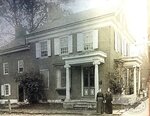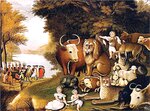

Today you can grab a cup of coffee or sit for breakfast/lunch in the house (Langhorne Coffee House) that was built by Gilbert Hicks (1728-1787) in 1763, the house where Edward Hicks (April 4, 1780-Aug. 23, 1849), Quaker preacher and folk art painter, was born.
Edward’s grandfather would commute five miles north to Newtown, then the county seat, for his work as chief justice and leading official of the British Crown. Isaac Hicks (1748-1836), Gilbert’s son, lived and worked in Newtown. He was a land surveyor, justice of the peace, prothonotary of Bucks County, and the father of Edward Hicks.
In 1775, both sided with the Non-Associators of Newtown (who paid a fine instead of serving in the Revolutionary War) and avoided any activities that had to do with the move toward Revolution.
Deeply impressed with the power of England, Gilbert with honest conviction read a proclamation forbidding the residents from taking up arms against the British, and offering pardons to anyone who would surrender at that time on Oct. 3, 1776. Newtown was soon in a wild state of excitement. Many local citizens were outraged, deeming Gilbert a traitor, and a group started on horseback to Four Lanes End to arrest him; thus, ending the career of a man who had once been one of the county’s most respected judges.
Gilbert escaped and, ultimately, settled in Nova Scotia, which remained under King George III. He was given land and a pension for his loyalty and never returned to Four Lanes End. There was no evidence of cooperation with the British. Gilbert died in Digby, Nova Scotia in 1786.
Gilbert was automatically convicted of high treason and his 40 acres were confiscated as enemy property, which included the house, tannery, and the hotel-tavern. Documents mention that Isaac and his family moved into Gilbert’s mansion to escape the tensions in Newtown. Isaac was forced to resign his position as court prothonotary, which left him without an income and with nowhere else to live.
When Gilbert’s property came up for auction on Aug. 24, 1779, Isaac won the bid, but did not pay until Nov. 3, 1779.
In the meantime, William Goforth had purchased the property. This started a dispute. Isaac asserted that he had the title by right of the deed of gift bestowed on him by his father. This dispute allowed Isaac to live in Gilbert’s house until April 16, 1781, when the court decided in Goforth’s favor.
During this time Edward, the Quaker preacher and folk artist known for his “Peaceable Kingdom” series of paintings, was born on April 4, 1780, in his grandfather’s house.
Edward’s mother passed away when he was a year old and Isaac was forced to find homes for his children. Edward went off to Newtown to the Twining Family, until the age of 13 when Isaac arranged for him to apprentice with his friends and carriage makers William and Henry Tomlinson in Four Lanes End.
Between April 1793 and October 1793, 13-year-old Edward lived and apprenticed at the “Signature House”(109 W. Maple Ave.), where he was to learn carriage painting.
But a fire forced everyone to move next door to the Tavern (Hotel) from October 1793 to August 1795, while the Tomlinsons earned enough money to rebuild their carriage shop. Edward was bartender and hostler at the hotel.
On Aug. 12, 1795, Edward Hicks and the Tomlinsons moved to 201 S. Bellevue Ave (First National Bank) and Edward finished out his painting apprenticeship.
He left Four Lanes End in the winter 1800 eventually moving to Hulmeville. He walked the 2.5 miles to the Middletown Friends (453 W. Maple Ave.), where he began his Quaker faith as well as married Sarah Worstell on Nov. 17, 1803.
Edward Hicks was born in Langhorne, learned to paint in Langhorne, married in Langhorne and found his Quaker faith here in Langhorne. Langhorne was woven throughout his life. Come walk in his footsteps.
Visit us at www.historiclanghorne.org for tours and events or stop by 160 W. Maple Ave. on Wednesdays and Saturdays between 10 and noon, or on Wednesdays from 7 p.m. to 9 p.m., to purchase a self-guided walking tour book.
“Heralding Our History” is a weekly feature. Each month, the Herald delves into the history of one of its towns.
Join our readers whose generous donations are making it possible for you to read our news coverage. Help keep local journalism alive and our community strong. Donate today.